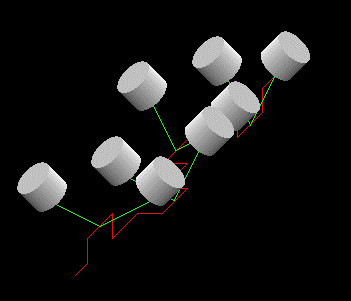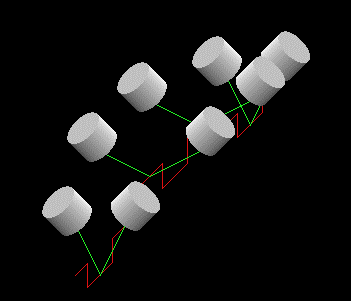Welcome to the Forum NeiNastran. Brilliant post. Usually as a Grumpy Old Man

I would have said put it in our alternate engine thread. Pardon me.

The company and inventor - Eddie Paul - EP Industries could fit easily into 10 F1T threads. The CEM could be an engine, turbocharger, supercharger, hydraulic 'engine' along the lines of the hydristor, KERS. Conceptual, don't quibble on having the corner on all concepts

Nothing is completely new except maybe a time machine patent.

This is a really interesting device/engine and company, The CEM is already being used by the US military to cool airborne lasers, now thats a high capacity pump, the US seals use it on decontamination pumps, 3 gallons a minute on a cordless Dewalt drill.

Conceptual, everything looks like something else

Eddie Paul does everything from a 3D lens systems to a replica shark/submarine for Cousteau so they can swim among great white shark

To custom cars for the movie Cars To enhanced 3D effects for the movie Cars to a new design for an English wheel so you can bang out body panels in your garage

, to a video on pin stripping. This guy Eddie Paul is all over the map and really could inspire anyone.

. The CEM as an engine is being considered for the Dusenberg 8 project designed by Jeff Teague. Theres a car designer with credentials . Heres an excerpt from an article about the CEM being used as an internal combustion engine.
The conventional IC engine design must meet a fine balance between effective piston-to-wall sealing and engine failure due to piston-to-wall friction. This balance is a unique science of metallurgy and expansion/compatibility coefficients of known materials. A minute amount of compression loss into the crankcase is acceptable providing the allowed Delta Pressure is not disproportionate as with a set of worn rings creating excessive leakage. This blow-by constitutes a normal loss of compression and volume, which must be vented from the crankcase into the atmosphere. As running time accumulates, however, and ring/cylinder wall deterioration creates an abnormal volume of pressure loss into the crankcase, a major overhaul or engine failure becomes eminent.
The CEM assembly is radically different in this concept since venting of the cylinder block is not required, hence, total combustion efficiency is achieved. This occurs through compression chamber pressure equalization. The CEM engine’s compression/power stroke builds pressure within the cylinder block until it becomes equal to the combustion chamber pressure. A gas pressure seal is formed thereby sealing the combustion chamber as high-pressure flows to a low-pressure area.
The cylinder and pistons are the only moving parts in the CEM engine; a 6-piston/12-cylinder CEM therefore has 7 internal moving parts. When you consider the myriad rods, bearings, pins, shafts, and valves at motion within a conventional four-stroke engine or even a rotary-piston engine, it is not difficult to understand where the CEM gains its performance and durability advantages. Two 360-degree sleeve halves enclose the CEM piston/cylinder assembly. The inner edges of the two sleeves meet to form a concentrically located sinusoidal guide path or camtrack.. This camtrack serves as a guide for the CEM piston’s fixed drive pins to follow. As the cylinder spins, the piston reflects the path of the camtrack, so the degree and frequency of stroke becomes a precise element of the CEM’s sinusoidal design or “grind” (See Cam Assembly illustration above).
The CEM’s length of stroke is determined by the degree of zenith on either side of the camtrack’s center. As the drive pin guides the piston from one zenith to the other, the cylinder block rotates each cylinder into port alignment. The CEM cycle minimizes the intake-compression-power-exhaust pulsations, which are separated along the sinusoidal path to provide a very smooth transition of air/fuel mixture to power.
Normally, the function of introducing an air/fuel mixture would occur through intake manifolding to a cylinder head with a series of cam/pushrod-activated intake and exhaust valves controlling the flow of air and fuel until burned gases exit through an exhaust manifold. An efficient 6-cylinder engine typically uses a 24-valve (4 valves per cylinder) arrangement requiring dual camshafts and critical valve lash adjustments. The CEM relegates this entire process to passive intake and exhaust ports located in the cylinder heads that cap each end of the cylinder/piston/sleeve assembly.
The CEM uses two end plates, or cylinder heads, that combine the functions of intake and exhaust porting, intake manifolding, and combustion chambering (i.e. location of glow plug). Each CEM head contains one intake port and one exhaust port. The diameter of each of these ports precisely matches the diameter of the six identical bores in the cylinder. As the cylinder block rotates, each bore intermittently aligns with an intake or exhaust port depending on the cycle. The spacing between each bore is precisely equivalent to the bore diameter, meaning that each stroke of the cycle occurs without overlap. Also, because the cylinder head ports effectively match the diameter of the bores, volumetric efficiency is maximized with a virtually unrestricted air/fuel-exhaust flow.
Once again. Welcome to the Forum NeiNastran.











